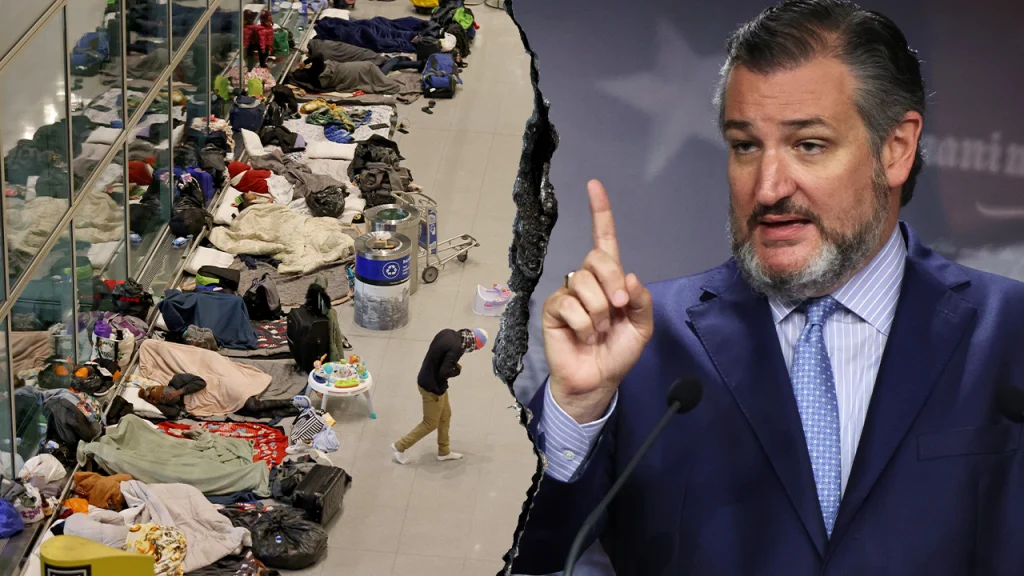Biden Administration Under Scrutiny for Airport Migrant Housing Plan
A recent Senate Commerce Committee report titled “Flight Risk” has uncovered what appears to be a coordinated effort by the Biden administration to use U.S. airports as temporary housing for migrants, despite safety and security concerns. The 47-page document details how the White House allegedly directed the Department of Transportation (DOT), Federal Aviation Administration (FAA), and other federal transportation agencies to identify airport facilities that could serve as shelters or processing centers for migrants. This directive came with urgency, as revealed in internal communications where an FAA official wrote to Massport in October 2023: “We have received a request from the WH to determine if there are available facilities on airport or surrounding areas… This is an immediate ask so please prioritize this effort.” Another DOT staff member candidly responded, “Yikes, this is definitely Fox News fodder in the making,” suggesting awareness of the political sensitivity surrounding these actions.
According to the report, at least eleven major airports—including Boston Logan, Chicago O’Hare, and New York’s JFK—were approached or pressured to repurpose parts of their facilities for migrant housing. What makes this particularly concerning from a regulatory perspective is that FAA officials appeared to sidestep normal protocols that would require federal approval under grant-assurance rules. Instead of following standard procedures, they “ignored them most of the time when airports used their facilities to house aliens,” the report claims. This occurred despite explicit warnings from airport authorities about their lack of appropriate resources and expertise for such operations. Massport, which operates Boston Logan International Airport, clearly communicated their concerns: “We are not designed or resourced to manage the intake of migrant populations… this would create a host of unintended safety and security consequences.” Nevertheless, Logan ultimately hosted up to 352 migrants overnight in Terminal E, incurring costs of approximately $779,000 for security, cleaning, and transportation.
The situation at Chicago’s O’Hare Airport presented even more troubling security implications. The report indicates that as many as 900 migrants were sheltered in a shuttle terminal between April 2023 and February 2024. During this period, police logged 329 service calls and 26 arrests for various offenses including thefts and disorderly conduct. There was even a death investigation during this time. Perhaps most concerning was the acknowledgment from Chicago officials that “asylum seekers [we]re not restricted to the staging area,” suggesting inadequate controls over movement within these sensitive transportation hubs. Meanwhile, at New York’s JFK Airport, the report highlights a 2024 security breach involving Kleber Loor-Ponce, described as “an alien from Ecuador [who] ran past a security post into ‘the secure area at [JFK],’ toward two runways.” When security personnel apprehended him, they discovered he was carrying a box cutter and scissors—potential weapons that should never have made it into secure areas of an international airport.
The Senate committee’s investigation found that the administration’s directives extended beyond just airports. The Federal Motor Carrier Safety Administration (FMCSA) was reportedly instructed to help produce a “Know Your Rights” pamphlet for bus passengers and to coordinate with states tracking bus companies transporting migrants. Similarly, the Federal Transit Administration (FTA) was “encouraged to remind local transit agencies that federal grants could be used to move migrants.” These actions, taken together, suggest a comprehensive strategy to utilize the nation’s transportation infrastructure for migrant support operations, potentially at the expense of its primary functions and security protocols. The committee characterized these directives as “a dangerous diversion” of federal transportation resources that were meant to ensure the safety and efficiency of America’s transportation networks.
The report’s conclusions are stark in their assessment of the administration’s actions. “The Biden-Harris administration made airports and aviation less secure,” it states, “by allowing and encouraging aliens to shelter at U.S. airports, by allowing improperly vetted aliens to fly into and throughout the United States, and by diverting needed federal air marshals to the border.” The implication is that these decisions compromised the core mission of transportation agencies by redirecting their focus and resources toward immigration matters. Senator Ted Cruz (R-Texas), Chairman of the Senate Committee on Commerce, Science, and Transportation, was equally pointed in his criticism: “This report exposes how the Biden Department of Transportation conspired with local leaders in New York, Boston, and Chicago to house migrants in airport facilities at taxpayer expense.” He further alleged that these decisions showed “how Biden’s open border policy coopted government agencies to put American citizens at risk.”
The revelations in this report highlight the complex intersection of immigration policy, transportation security, and resource allocation within the federal government. On one hand, the administration appears to have been seeking solutions to accommodate migrants within existing infrastructure during a period of increased border crossings. On the other hand, the report suggests these efforts may have circumvented established protocols and potentially compromised the safety and security systems that protect millions of travelers. What makes this particularly noteworthy is the apparent recognition among some officials that these actions might be problematic—as evidenced by the candid “Fox News fodder” comment—yet the directives proceeded nonetheless. The tension between humanitarian responses to migration and maintaining transportation security presents difficult trade-offs that require careful consideration of competing priorities.
This Senate report comes at a politically sensitive time as immigration remains a divisive issue in American politics. While the report focuses specifically on the use of transportation facilities and resources, it touches on broader questions about immigration policy, executive authority, and the proper role of federal agencies. What remains unclear is whether alternative solutions were adequately explored before turning to airports as temporary housing facilities, and whether the security concerns raised by airport authorities were given appropriate consideration in the decision-making process. As this story continues to unfold, it will likely prompt further debate about how to balance humanitarian responses to migration with the critical need to maintain the integrity and security of the nation’s transportation infrastructure, which millions of Americans rely on daily for safe travel and commerce.











